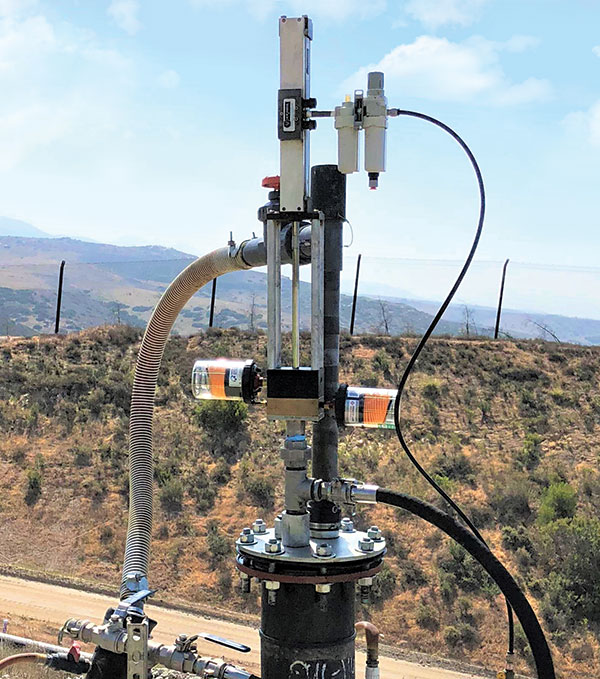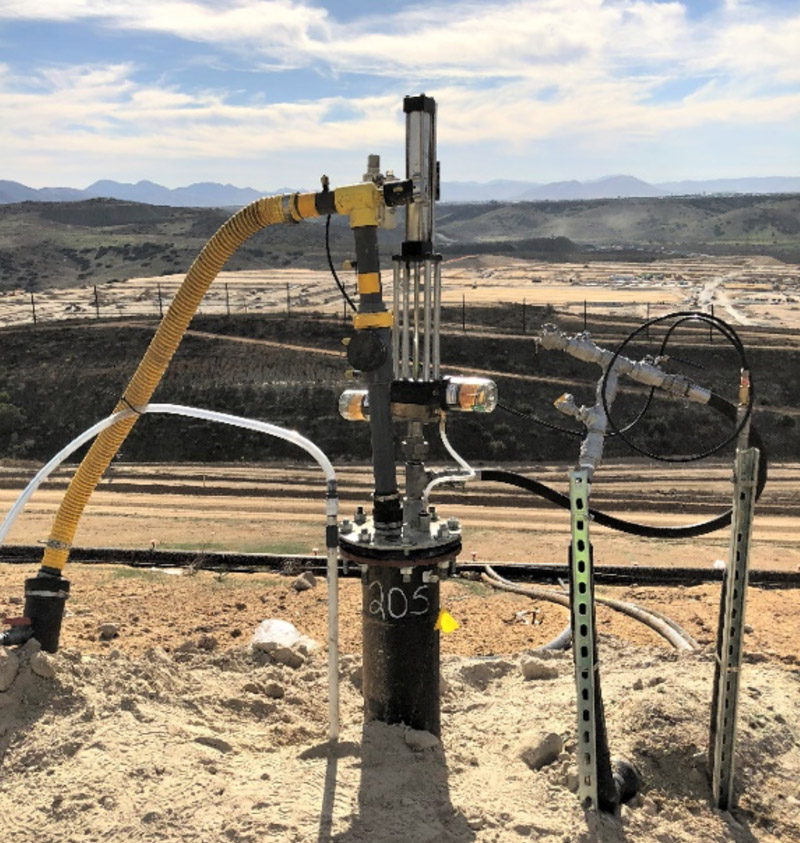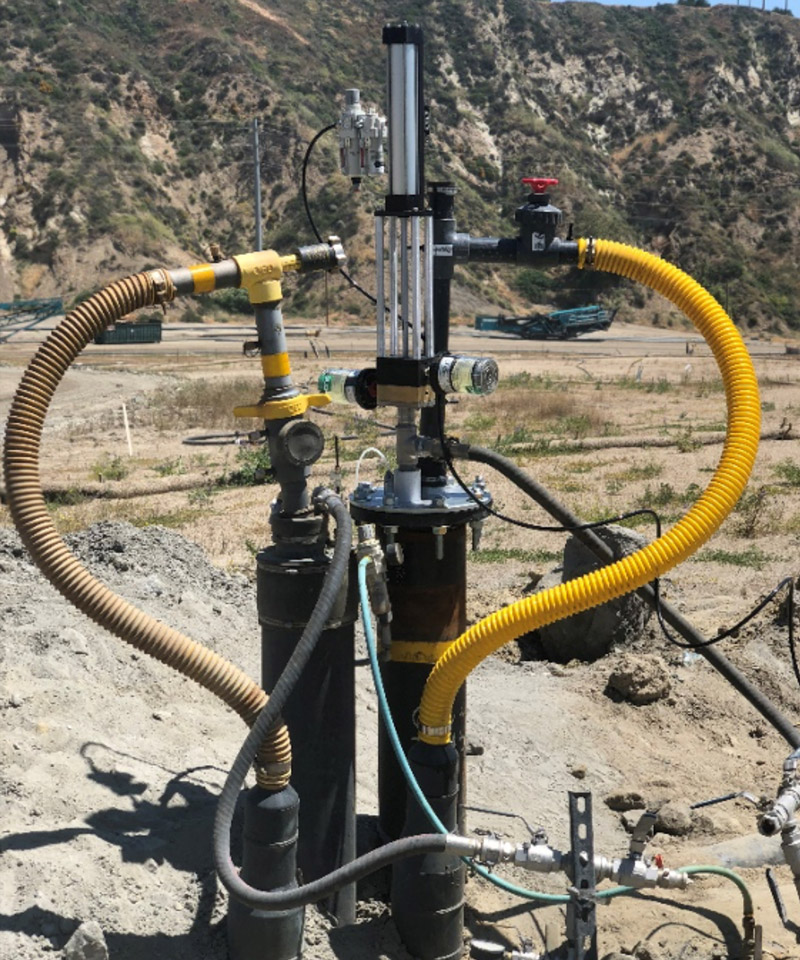A Strategy to Tame ET Sites
. . . And Keeping Them from Developing
"For reasons that are not entirely clear, incidents of elevated temperatures in municipal solid waste landfills are occurring at increasing frequency."
– University of Central Florida, June 2019
"(Elevated temperature) challenges may include regulatory compliance, damage to gas and leachate infrastructure, rapid settlement, low methane gas content, fugitive gas emissions and odor complaints, increasing leachate volumes with increasing chemical oxygen demand (COD) and salt content. . .
"Potential infrastructure damage at an ETLF (Elevated Temperature Landfill) includes softening and buckling of the components of the gas and leachate extraction systems." – Waste360, October 2016

The ETLF Issue
For the past several years, a growing number of landfill managers have confronted temperatures ranging from 150°F to 250°F or more (65°C to 121°C) from deep inside larger, wetter, maturing sites -- not from subsurface fires but from biological or chemical exothermic reactions within zones of the landfill itself.High concentrations of varied, recombinant leachate compositions in these Elevated Temperature Landfills (ETLFs) can lead to higher costs for treatment or even the refusal of local wastewater treatment plants to accept the leachate, according to a three-part series by Waste 360 in conjunction with ELEF (www.waste360.com/landfill-operations/diagnosing-and-understanding-elevated-temperature-landfills-part-1).

Costs to reverse early warming trends can be surprisingly low.
Elevated temperatures also may result in slope instability due to reduced waste strength or increased liquid- or gas-pore pressures; surprise sinkholes, and rapid settlement - all safety and infrastructure issues.
In addition, odor and the possibility of offsite gas migration and leachate release have resulted in public demands for tighter operations and oversight and, occasionally, litigation. Research into the causes and spread of ETLFs is ongoing.
Equipment Failures
ETLF events pose a significant threat to existing leachate and gas-well physical systems, including commonly used eductor/riser piping, tubing and pumps that were not designed for high-temperature use.
HDPE pipe or tubing is generally rated at 150°F (66 C°), a temperature at which air-push pump models also begin to struggle. If temperatures exceed 150°F, plastic piping often becomes elastic, and standard air-push pumps are prone to failure – gas-well systems can be compromised and leachate pumping halted. At this point, the site is in danger of becoming an ETLF.
Why Temperatures Rise
More sophisticated metering and monitoring of landfill gases is making it easier to deduce if higher temperatures are caused by subterranean fires (more carbon monoxide present) or bio-chemical reactions (at high temperatures, methane can turn into hydrogen and other gases). Elevated concentrations of these gases combined with lower levels of methane may indicate the presence of an active bio-chemical condition – an ETLF problem.
Because liquid holds more heat than gas, failure to remove chemically reactive fluid means subsurface crevices generate increasing amounts of heat. The lighter gas, with the capability of dissipating heat far more easily, is forced away, often into open air or offsite, while the heated fluid remains. Absent intervention, the site is in difficulties.
Fighting Back/Getting Out Front
Managers at some of the most challenging ETLFs, however, have developed new strategies and tactics shown to slow and then reverse increases in site temperatures –getting ahead of the problem before a warming site becomes a full-blown ETLF.
If the heat source is exothermic reaction, dewatering is necessary, allowing cooler, lightweight gas to replacing hotter fluid in underground fissures. Over time, as the hotter liquids are pumped out (conduction), more gases are collected and recovered (convection), reducing overall site temperatures -- pulling back from the ETLF threshold.
Elevated-Temperature Piston Pumps
Positive-displacement piston pumps are playing a key role in ET dewatering. Unlike common air-drive models, piston pumps can be built with materials of construction that withstand heat to 300°F+ (150deg;C). They will pump virtually anything flowable, regardless of composition, pH, viscosity, grit or vacuum while resisting biological and chemical attack.
By design, piston pumps cannot introduce oxygen into the discharge system and cannot exhaust landfill gases into the atmosphere. Drivers are mounted above the wellhead or sump, and all power and drive components are above ground for safer and faster maintenance.
A site that already has crossed the ETLF threshold generally will require significant changes to its infrastructure components – both pipes and pumps.
In addition to installing elevated-temp pumps, sites must replace stretched or otherwise failed HDPE piping. Discharge pipes must be above grade, and, importantly, must be sized to handle fluid flow, allowing access to clean out scale and other build up. Managers report that steel hard pipe has been a reliable solution.
Reducing Incapacitating Temperatures
As the numbers of elevated-temperatures sites grow and research begins to explain why, landfill managers increasingly are turning to specialty-materials piston-pumping systems to reduce incapacitating temperatures.
And if aggressive LFG well dewatering can reverse warming trends before infrastructure breakdown, the costs can be surprisingly low.
Case Study – A North American ETLF Site
More than a decade ago, a now-closed landfill outside a U.S. city was experiencing a public and legal reaction to increased odor, offsite gas migration and leachate release.
The accumulation of altered-chemistry leachate – heavier than gas and changing its composition with age – is now believed to have been the cause, eventually creating a subsurface exothermic reaction over several acres that raised temperatures to an estimated 200°F or more in some zones.
The common air-push pumps on site were not designed for elevated temperatures – reducing or incapacitating the pumps' ability to dewater that portion of the landfill. With leachate continuing to accumulate, landfill gas was pushed into the open air, beyond the site's ability to capture and flare it, and the methane migrated into nearby basements. A court ordered improvement and mandated dewatering of at least 120,000 gallons per month.

A maintenance manager discusses how his landfill is reducing elevated temps – Q&A.
Not then knowing the causes of the air-push pump failures but understanding a new approach was necessary, managers installed several Blackhawk top-head-drive, positive-displacement pneumatic piston pumps in the area where common air-push and submersible models failed.
The Blackhawks notably outperformed the older pump types, although issues surfaced as more piston pumps were added -- including relatively rapid seal wear and field technicians' unfamiliarity with the new pumps.
So, in the spirit of need and opportunity for growth, the landfill's management team partnered with Blackhawk to diagnose problems, better understand what was happening at the most challenging wells and then develop new design concepts and test new materials to meet unique needs. Now 10 years later, both the actively managed landfill and Blackhawk have benefitted significantly from the mutual exchange of ideas and continuous onsite proof testing.
At the landfill:
- Liquid levels have been reduced and stabilized below mandated levels in the ET zone.
- Flow rates have increased by more than 15 percent with the addition of steel infrastructure tubing and stainless-steel pump parts.
- ET zone temps have been lowered at least 25 percent to roughly 150°F – still too elevated for common landfill pumps, but low enough to keep gases flowing to the flares.
- At any one time, between 30 and 35 of the original Blackhawk pneumatic piston pumps remain in operation, a result of conscientious maintenance and technician training.
- A newly designed, lower-cost ET pump model is being tested.
- Significantly, the site is meeting its court mandates and odors have virtually disappeared.
At Blackhawk:
- A new line of piston pumps was developed for ETLFs, both pneumatic and electric powered, with a solar model proposed.
- A variety of stuffing-box designs, components and materials have improved the durability, ease of maintenance and replacement of seals and blocks for all Blackhawk pumps.
- Blackhawk's now-standard zinc-coated stainless-steel flanged well seal was developed with a unique external stay-clean system.
- All pneumatic tie-rod dimensions were extended to allow greater distance between driver and stuffing box.
- Most significantly, a greater understanding of the nature of ETLFs has helped sites improved the quality of life for neighboring residents.
Q&A with the landfill's maintenance manager:
Is the entire landfill elevated temperature?
No, about one third.
What are some of the major challenges you face today?
- We must meet the court's pumping requirements and maintain liquid levels.
- Our sites are very viscous and pH levels in the past sometimes varied quite a bit between wells; we now are trying to new connections.
- Over time, heat stretches HDPE tubing and settlement crushes plastics. We have gone to stainless steel for pumps and steel for casings when that happens.
- Pumping from sides of the site is difficult and many of our wells are angled.
How deep are the ET wells?
Anywhere from 12 feet to 110 feet or more.
One advantage of Blackhawk's piston pumps is the ability to easily swap out the top-head-drive motors and even downhole pumps. How often do you do this?
We do move the top-head drivers around. How often depends on the well. Blackhawk drivers are easy to remove and replace on other wells.
Why Blackhawk?
Because Blackhawk pumps work when others can't. The other pumps don't work in hot temperatures. Blackhawks draw liquid levels down to the bottom of the well; pump gooier liquids and move grit as well as liquid. Other pumps must be nearly vertical to work right, or floats will hang up. Blackhawks can get into angled wells with small (1¼") clearances.
They also can go deeper, and they last longer. They are easier and faster to maintain and repair, which means less down time. And we can work with Blackhawk to improve how we pump.
About Blackhawk Technology
Blackhawk Technology Company is the industry's originator and leading provider of elevated temperature piston pumps and products.
The positive-displacement, reciprocating-action ET pumps are available in both pneumatic and electric models, incorporating a broad range of construction materials customizable to site requirements. Blackhawk pumps are at work in ETLF zones across North America.
